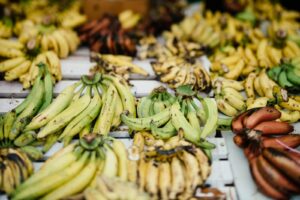At first glance, plantains look almost identical to their sweet banana cousins. But cut one open for a taste, and you quickly realize plantains are very different. So how exactly does plantain taste compared to banana? This article will contrast the flavor, uses and nutrition to settle the debate.
Table of Contents
An Introduction to Plantain vs Banana
Plantains, also called cooking bananas, are a starchy fruit popular in tropical regions:
- Grown in tropical climates including Central America, Africa, Southeast Asia and the Caribbean.
- Contains more starch and less sugar than sweet dessert bananas.
- Requires cooking before eating unlike snackable raw bananas.
- Used in savory dishes, stews and mashes rather than fruit salads or smoothies.
- Available year-round in supermarkets and ethnic grocers, often green. The skin turns black when very ripe.
Now let’s contrast the flavor of plantains versus classic bananas.
Does Plantain Taste Like Banana? Key Flavor Differences
At first bite, plantains have a much starchier, less sweet taste and flavor than bananas. More specifically:
- Plantains are lower in sugar so taste less sweet, especially when unripe. Riper plantains develop more sweetness.
- Starchier and drier mouthfeel than bananas, without the banana’s creamy lushness.
- Savory, almost potato-like flavor notes rather than fruity banana notes.
- Slight tang of acidity and bitterness, especially when green.
- Refrigeration brings out the starches and diminishes sweetness.
While plantains share botanical connections with bananas, their flavor and texture differ significantly when tasted side by side.
How Does Cooking Change Plantain’s Flavor?
Cooking brings out the sweetness in starchy plantains:
- Raw plantains are very firm with subtle flavor.
- Frying makes plantains caramelized, sweet and soft.
- Boiling or roasting softens plantains and develops more rich, maple-like sweetness.
- Browning and blackening add rich depth of flavor and sweetness.
Riper, blacker plantains tend to taste sweeter with floral notes when cooked. Green plantains stay starchy requiring more time to soften.
Dishes Showcasing Plantain’s Unique Flavor
Plantains shine in these savory to sweet preparations:
- Mangu – Mashed plantains with onions, garlic and cheese.
- Fritters – Caramelized fried plantain patties, often filled.
- Tostones – Fried then smashed unripe plantain disks.
- Chips – Thinly sliced plantains fried into salty, crunchy chips.
- Mojo – Fried plantains with garlicky citrus sauce.
- Sweet plantains – Browned very ripe plantains sometimes served with ice cream.
Cooking plantains develops their flavor and sweetness potential beyond green bananas.
Nutrition Comparison: Plantains vs Bananas
Plantains are starchier and lower in sugar with more fiber and nutrients versus sweeter bananas:
- Plantains: Higher in vitamin A, C, B6, magnesium and potassium. Also more fiber.
- Bananas: Higher in vitamin B6, biotin and copper. Also more net carbs from sugar.
- Plantains have a lower glycemic index, meaning less impact on blood sugar.
- Both contain beneficial antioxidants and nutrients, but plantains offer more fiber and vitamins.
Tips for Selecting, Ripening and Cooking Plantains
To maximize plantain flavor:
- Look for plump, unbruised fruit without black spots.
- Allow green plantains to ripen at room temp for a few days to develop sweetness.
- Keep yellow plantains stored in a paper bag to increase sweetness.
- Roast, fry or boil ripe plantains until deeply caramelized for richer flavor.
- Remove tough strings and trim ends before cooking to improve texture.
The Verdict: Plantains Have a Savory Starchier Taste Than Bananas
While plantains may resemble their sugary banana cousins, the flavor differs significantly, with plantains exhibiting more starch, less sweetness and more potato or squash-like savoriness. Cooking brings out the sugar in ripe plantains, while green ones maintain a potent starchy tang. Embrace plantains for their nutrition and learn how their distinctive taste shines in various dishes.


